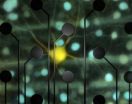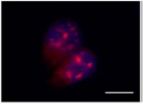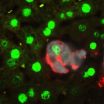(Press-News.org) HPV (human papillomavirus) infection is widely known to induce cancer. Many of the mutations that cause this virally-induced cancer are caused by a family of genes that normally combats viral infections, finds new UCL (University College London) research.
This raises the possibility of developing drugs to regulate the activity of these genes to prevent HPV-associated cancers from developing and reduce the ability of existing cancers to evolve resistance to treatments.
The research, published in Cell Reports, shows for the first time that genes from the 'APOBEC' family, which help to fight off viral infection, actually cause mutations that lead to HPV-associated cancer. This research was funded by the Rosetrees Trust, a charity dedicated to supporting pioneering medical research, with additional funding from the Debbie Fund and Cancer Research UK.
"Genes from the APOBEC family encode proteins that modify the DNA of invading viruses, causing mutations that prevent the virus from replicating," explains senior author Dr Tim Fenton, of the Tumour Virus team at the UCL Cancer Institute. "We now provide evidence that they can also cause mutations in our own DNA after HPV infection, leading to cancer."
Over 99% of cervical cancers are caused by HPV infection, and HPV is responsible for approximately 26,700 new cases of cancer each year in the United States. Previous genetic studies have shown associations between APOBEC genes and cancer.
"Our results show that after HPV infection, APOBEC genes cause very specific mutations, with very high frequency in a cancer-promoting gene called PIK3CA, thus leading to tumour development," says co-lead author Dr Stephen Henderson of the Bill Lyons Informatics Centre at the UCL Cancer Institute. "It is not clear why HPV infection causes the APOBEC genes to misbehave and mutate PIK3CA. It could be that the body responds to HPV infection with increased ABOBEC activity, simply making 'friendly fire' more likely. Alternatively, there may well be something about the virus that causes the APOBEC response to wrongly target the body's own genes for mutation."
Mutated PIK3CA (p110α) protein is known to play a key role in the development of a range of cancers, so it is a hot target for new drugs. The new research could explain why particular PIK3CA mutation variants are so commonly found in HPV-associated cancers.
"While it is too early to consider targeting APOBEC genes to prevent tumour formation, it is nonetheless fascinating to work out how HPV drives tumour formation through their activity," says co-lead author Ankur Chakravarthy, a PhD student in the Tumour Virus team. The team's aim is now to learn what happens following HPV infection of cells in which APOBEC genes have been deleted.
The research could also inform screening procedures, as there are variants of particular APOBEC genes that are known to affect cancer risk. For example, a variant of the specific gene APOBEC3B is known to approximately double breast cancer risk. This variant is common in East Asia, with approximately 80% of Indonesians carrying the gene variant. By contrast, only around 2% of the African population carry this variant.
"Previous studies have shown that APOBECs cause mutations in a range of cancers but our finding that they mutate key cancer genes implicates them as drivers of tumour development, particularly in HPV-associated cancers. It will be interesting to see whether such APOBEC variants can predict the risk of developing cancer after HPV infections," says Dr Tim Fenton. "If at-risk groups could be identified by genetic testing, this could have important implications for HPV screening and vaccination programmes."
INFORMATION: END
Our own treacherous immune genes can cause cancer after viral infection
Mutations that cause cancer following human papillomavirus infection are caused by a family of genes that normally protect against viral infections, finds new UCL research
2014-06-05
ELSE PRESS RELEASES FROM THIS DATE:
Cellular traffic control system mapped for the first time
2014-06-05
Cells must transport nutrients and messenger cargos through its membrane and transport them within the cell at the correct time and place. This procedure is complex and is regulated with the help of specific genes. If disturbances in the transport mechanism arise, severe diseases, such as diabetes, cancer and diverse neurological pathologies, are the consequence. The discovery of the molecular principles of cellular transport was honored with the Nobel Prize of physiology and medicine in 2013. While knowing the intracellular roads and the functioning of the cars that use ...
Unmasking viral invaders
2014-06-05
If you have it, you probably don't know it. Cytomegalovirus, or CMV, is perhaps one of the biggest pathogens you've never heard of—big, both proportionately and epidemiologically. It contains approximately 200 genes, compared to HIV's paltry 18, and it's everywhere. You can catch it as a preschooler salivating over blocks, or as a teenager experiencing your first kiss. Once you have it, you have it for life.
Good news: If you're healthy, it's harmless. Your T cells keep it in check, and you'll be none the wiser.
Bad news: If you have any medical condition that dampens ...
Making artificial vision look more natural
2014-06-05
In laboratory tests, researchers have used electrical stimulation of retinal cells to produce the same patterns of activity that occur when the retina sees a moving object. Although more work remains, this is a step toward restoring natural, high-fidelity vision to blind people, the researchers say. The work was funded in part by the National Institutes of Health.
Just 20 years ago, bionic vision was more a science fiction cliché than a realistic medical goal. But in the past few years, the first artificial vision technology has come on the market in the United States ...
Discovered a new way to control genetic material altered in cancer
2014-06-05
When we talk about genetic material, we are usually referring to the DNA (deoxyribonucleic acid) that we inherit from our parents. This DNA is the factory where is built a similar molecule called RNA (ribonucleic acid) which produces our proteins, such as hemoglobin or insulin , allowing the lives of our cells. But there is a special group called non-coding RNA that has a more enigmatic function.
The best known is microRNAs, tiny molecules that are responsible for turning on or off our genome like an electrical current switch. Today, an article published in the prestigious ...
A new model of liver regeneration
2014-06-05
Harvard Stem Cell Institute scientists at Boston Children's Hospital have new evidence in mice that it may be possible to repair a chronically diseased liver by forcing mature liver cells to revert back to a stem cell-like state.
The researchers, led by Fernando Camargo, PhD, happened upon this discovery while investigating whether a biochemical cascade called Hippo, which controls how big the liver grows, also affects cell fate. The unexpected answer, published in the journal Cell, is that switching off the Hippo-signaling pathway in mature liver cells generates very ...
Vanderbilt scientists discover that chemical element bromine is essential to human life
2014-06-05
Twenty-seven chemical elements are considered to be essential for human life.
Now there is a 28th – bromine.
In a paper published Thursday by the journal Cell, Vanderbilt University researchers establish for the first time that bromine, among the 92 naturally-occurring chemical elements in the universe, is the 28th element essential for tissue development in all animals, from primitive sea creatures to humans.
"Without bromine, there are no animals. That's the discovery," said Billy Hudson, Ph.D., the paper's senior author and Elliott V. Newman Professor of Medicine.
The ...
Flowers' polarization patterns help bees find food
2014-06-05
Like many other insect pollinators, bees find their way around by using a polarization sensitive area in their eyes to 'see' skylight polarization patterns. However, while other insects are known to use such sensitivity to identify appropriate habitats, locate suitable sites to lay their eggs and find food, a non-navigation function for polarization vision has never been identified in bees – until now.
Professor Julian Partridge, from Bristol's School of Biological Sciences and the School of Animal Biology at the University of Western Australia, with his Bristol-based ...
Stem cells hold keys to body's plan
2014-06-05
Case Western Reserve researchers have discovered landmarks within pluripotent stem cells that guide how they develop to serve different purposes within the body. This breakthrough offers promise that scientists eventually will be able to direct stem cells in ways that prevent disease or repair damage from injury or illness. The study and its results appear in the June 5 edition of the journal Cell Stem Cell.
Pluripotent stem cells are so named because they can evolve into any of the cell types that exist within the body. Their immense potential captured the attention ...
Couples sleep in sync when the wife is satisfied with their marriage
2014-06-05
DARIEN, IL – A new study suggests that couples are more likely to sleep in sync when the wife is more satisfied with their marriage.
Results show that overall synchrony in sleep-wake schedules among couples was high, as those who slept in the same bed were awake or asleep at the same time about 75 percent of the time. When the wife reported higher marital satisfaction, the percent of time the couple was awake or asleep at the same time was greater.
"Most of what is known about sleep comes from studying it at the individual level; however, for most adults, sleep is a ...
The connection between oxygen and diabetes
2014-06-05
Researchers at the University of California, San Diego School of Medicine have, for the first time, described the sequence of early cellular responses to a high-fat diet, one that can result in obesity-induced insulin resistance and diabetes. The findings, published in the June 5 issue of Cell, also suggest potential molecular targets for preventing or reversing the process.
"We've described the etiology of obesity-related diabetes. We've pinpointed the steps, the way the whole thing happens," said Jerrold M. Olefsky, MD, associate dean for Scientific Affairs and Distinguished ...
LAST 30 PRESS RELEASES:
iPS cells from dish to freezer and back
Deep neural networks enable accurate pricing of American options under stochastic volatility
Collective risk resonance in Chinese stock sectors uncovered through higher-order network analysis
Does CPU impact systemic risk contributions of Chinese sectors? Evidence from mixed frequency methods with asymmetric tail long memory
General intelligence framework to predict virus adaptation based on a genome language model
Antibiotic resistance is ancient, ecological, and deeply connected to human activity, new review shows
Vapes, pouches, heated tobacco, shisha, cigarettes: nicotine in all forms is toxic to the heart and blood vessels
From powder to planet: University of Modena engineers forge a low-carbon future for advanced metal manufacturing
Super strain-resistant superconductors
Pre-school health programme does not improve children’s diet or physical activity, prompting call for policy changes, study finds
Autumn clock change linked to reduction in certain health conditions
AI images of doctors can exaggerate and reinforce existing stereotypes
Where medicine meets melody – how lullabies help babies and parents in intensive care
We may never be able to tell if AI becomes conscious, argues philosopher
AI video translation shows promise but humans still hold the edge
Deep ocean earthquakes drive Southern Ocean’s massive phytoplankton blooms, study finds
Without campus leftovers to pick through, the beaks of this bird changed shape during the pandemic
High-dose antibiotic does not reduce mortality in tuberculous meningitis
How many insects fly in the sky above the USA?
Could cheese protect your brain health?
Who faces more difficulty recovering from stroke?
Colliding galaxies create the brightest, fastest growing black holes at their center
New BrainHealth research reveals tradeoffs on sleep with cannabis use for chronic pain
Aging-US now on ResearchGate, enhancing visibility for authors and readers
'Molecular glue' stabilizes protein that inhibits development of non-small cell lung cancer
Mount Sinai Health System is recognized in 2025 Chime Digital Health Most Wired survey
From prey to predator: How carnivores spread beneficial fungi
Menopause symptoms may be frequent and have negative effects, according to female endurance athletes
US Congressmembers’ responses on X to mass shooting events differ along party lines
KAIST-UEL team develops “origami” airless wheel to explore lunar caves
[Press-News.org] Our own treacherous immune genes can cause cancer after viral infectionMutations that cause cancer following human papillomavirus infection are caused by a family of genes that normally protect against viral infections, finds new UCL research


